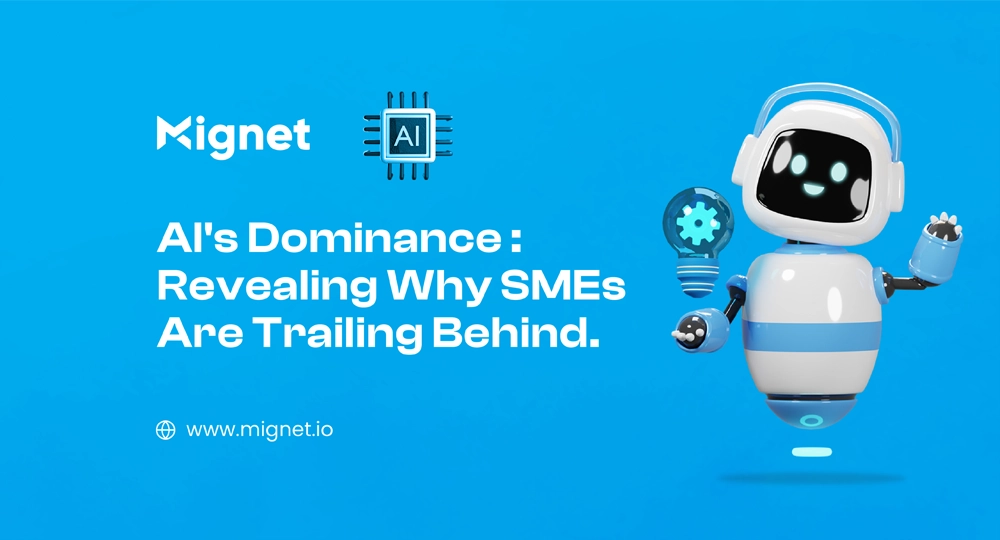
AI's Dominance: Revealing Why SMEs Are Trailing Behind
Table of Contents
Revealing AI's Dominance
Artificial Intelligence (AI) has rapidly transformed industries, ushering in a new era of innovation and efficiency. However, for many Small and Medium Enterprises (SMEs), keeping up with AI’s pace has proven to be a significant challenge.
In this blog, we will explore the reasons behind why SMEs are lagging behind in AI adoption. We will delve into the barriers they face and provide insights on how SMEs can bridge the gap, harness AI’s potential, and compete effectively in this AI-dominated landscape.
1.The AI Revolution: An Overview
Before we delve into the challenges faced by SMEs, let’s understand why AI has become such a game-changer in the business world.
AI encompasses a range of technologies, including machine learning, natural language processing, and computer vision, all of which allow computers to perform tasks that typically require human intelligence. These capabilities have far-reaching implications:
Automation:
AI can automate repetitive tasks, freeing up human resources for more complex work.
Data Analysis:
AI processes vast amounts of data quickly, providing valuable insights and predictions.
Personalization:
AI enables businesses to deliver personalized experiences to customers, increasing engagement and satisfaction.
Cost Savings:
AI can reduce operational costs through efficiency and process optimization.
3.The AI Challenge for SMEs
SMEs have a distinct set of challenges when it comes to adopting AI technologies. Let’s explore why they often find themselves trailing behind in the AI race.
Barriers to AI Adoption
Cost Constraints:
Developing and implementing AI solutions can be costly. SMEs often lack the financial resources needed to invest in AI technology.
Lack of Expertise:
AI requires specialized skills and knowledge. SMEs may struggle to find and afford AI experts or provide training to existing staff.
Data Limitations:
AI thrives on data, but many SMEs may have limited access to relevant and high-quality data, hampering AI’s effectiveness.
Risk Aversion:
SMEs may be risk-averse, as the initial AI investments might not guarantee immediate returns. This fear can slow adoption.
Integration Challenges:
Integrating AI into existing systems and processes can be complex and disruptive, making SMEs hesitant to take the plunge.
4.Overcoming Barriers and Embracing AI
While the challenges are real, SMEs can take steps to overcome them and leverage AI’s potential effectively. Here’s how:
1. Start Small and Build Knowledge
Begin with small AI projects to gain practical experience. This allows SMEs to build knowledge and confidence while minimizing initial investment.
2. Collaborate and Seek Partnerships
Consider partnerships with AI-focused companies or consultants who can provide expertise and guidance. Collaboration can help navigate the complexities of AI adoption.
3. Explore Cloud-Based AI Services
Cloud-basedAI services offered by tech giants like Amazon, Google, and Microsoft provide accessible and cost-effective AI solutions for SMEs.
4. Prioritize Data Collection and Quality
Invest in data collection and maintenance. High-quality data is the lifeblood of AI, and SMEs need to ensure their data is clean and accessible.
5. Employee Training and Development
Invest in your employees’ skills by offering training programs and upskilling opportunities. An AI-literate workforce can drive AI adoption within the organization.
The Future of SMEs in an AI World
As the digital landscape continues to evolve, Small and Medium Enterprises (SMEs) find themselves at a crossroads. The proliferation of Artificial Intelligence (AI) is reshaping business dynamics, and SMEs must adapt to thrive in this new era.
AI offers SMEs the potential for increased efficiency, competitiveness, and innovation. However, failing to embrace AI can lead to significant challenges. In an AI-dominated world, SMEs that lag behind risk falling into obsolescence. They may struggle to keep up with customer demands for personalized experiences, data-driven insights, and rapid service delivery.
The future for SMEs in an AI world is both challenging and promising. Those who invest in AI and make it an integral part of their business strategies are likely to enjoy a competitive edge. They can automate routine tasks, harness data for informed decision-making, and improve customer interactions.
SMEs that resist AI adoption, on the other hand, could face stagnation or decline. As AI technology becomes more accessible and affordable, the gap between AI-empowered businesses and those without AI will likely widen.
In essence, the future of SMEs in an AI world hinges on their ability to recognize the transformative potential of AI, overcome adoption barriers, and embrace AI as a driving force for growth and innovation.
5.Conclusion: Paving the Path to AI Success for SMEs
In conclusion, AI’s dominance is undeniable, and SMEs must catch up to thrive in today’s business landscape. While the barriers to AI adoption are substantial, they are not insurmountable. SMEs can take strategic steps to harness the power of AI, including starting small, seeking partnerships, and investing in data and employee training.
By doing so, SMEs can not only close the AI adoption gap but also find themselves at the forefront of innovation and success in an AI-driven world. The key to success lies in recognizing AI as an opportunity, not a challenge.
Unlock productivity: Join our Email List
Download Our Profile
Get to know more about Mignet Technologies by downloading our profile.



